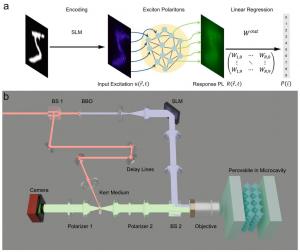Ultrafast neuromorphic computing driven by polariton nonlinearities
GA, UNITED STATES, June 6, 2025 /EINPresswire.com/ -- Neuromorphic computing, inspired by the human brain, offers a path to faster and more efficient AI. In a pioneering breakthrough, Chinese scientists demonstrate the first use of perovskite microcavity exciton-polariton as a platform for neuromorphic computing, achieving 92% accuracy in digit recognition with single-step training. Operating at room temperature and driven by strong optical nonlinearity, the system enables ultrafast and power-efficient computation—paving the way for next-generation light-based intelligent hardware.
Neuromorphic computing, inspired by the human brain, is considered as the next-generation paradigm for artificial intelligence (AI), offering dramatically increased speed and lower energy consumption. While software-based artificial neural networks (ANNs) have made remarkable strides, unlocking their full potential calls for physical platforms that combine ultrafast operation, high computational density, energy efficiency, and scalability. Among various physical systems, microcavity exciton polaritons have attracted attention for neuromorphic computing due to their ultrafast dynamics, strong nonlinearities, and light-based architecture, which naturally align with the requirements of brain-inspired computation. However, their practical use has been hampered by the need for cryogenic operation and intricate fabrication processes.
In a new paper published in eLight, a team of scientists led by Professor Qihua Xiong from Tsinghua University and Beijing Academy of Quantum Information Sciences report a demonstration of neuromorphic computing utilizing perovskite microcavity exciton polaritons operating at room temperature. Their novel system achieves high-speed digit recognition with 92% accuracy using only single-step training and opens new opportunities for scalable, light-driven neural hardware.
The core of their system is a planar FAPbBr3 perovskite microcavity which supports exciton-polariton condensation under non-resonant optical pumping. Input images from the MNIST dataset are optically encoded by a spatial light modulator (SLM) and projected onto the microcavity as spatially structured excitation beams. The resulting polariton emission patterns serve as the output of the ANN, which is then linearly processed using ridge regression. Remarkably, this scheme requires no predefined network structure—only the physical response of the polariton system—and achieves competitive accuracy using a lightweight training set of 900 images.
“Unlike conventional approaches that rely on prefabricated structures or predefined network nodes, our method employs a fully connected spatial mapping, utilizing the entire perovskite sample area without additional structural constraints,” the corresponding author Qihua Xiong replied. This not only improves the system's scalability but also simplifies experimental realization.
What makes this system stand out is the intrinsic nonlinear and dynamical response of the polaritons. The researchers show that below the condensation threshold, the system behaves nearly linearly, while near and above threshold, nonlinearities emerge sharply, enhancing pattern discrimination. Moreover, by applying ultrafast Kerr-gated time-resolved photoluminescence, the team probes the temporal evolution of polariton responses. They find that polariton dynamics unfold on the picosecond scale and exhibit time-dependent nonlinear mappings, which significantly broaden the system’s capacity for processing complex and temporally varying inputs.
The researchers conclude that “perovskite microcavity exciton polaritons offer ultrafast processing speeds on the picosecond timescale and exhibit exceptionally strong nonlinear interactions, significantly surpassing those in traditional photonic systems.” These attributes make them powerful candidates for future physical neural networks capable of real-time, energy-efficient AI.
This work highlights the growing role of halide perovskites in next-generation photonic computing and marks an important step toward developing all-optical neuromorphic hardware—free from the energy and speed limitations of traditional electronics.
Original Source URL
https://doi.org/10.1186/s43593-025-00087-9
Funding information
This work was supported by the National Natural Science Foundation of China (grant No. 12434011) and the State Key Laboratory of Low-Dimensional Quantum Physics at Tsinghua University.
Lucy Wang
BioDesign Research
email us here
Legal Disclaimer:
EIN Presswire provides this news content "as is" without warranty of any kind. We do not accept any responsibility or liability for the accuracy, content, images, videos, licenses, completeness, legality, or reliability of the information contained in this article. If you have any complaints or copyright issues related to this article, kindly contact the author above.
Wicked Fabulous Champions LGBTQ+ Wellness with New Guide Exploring the Seven Dimensions of Self-Care
Fast Company Magazine Names Street Charity to World Changing Idea List
DON NOBLE TRANSFORMS FANTASY NOVEL INTO AUDIO THEATER
Kalendarium
Więcej ważnych informacji
 Jedynka Newserii
Jedynka Newserii

 Jedynka Newserii
Jedynka Newserii

Polityka

Wiceprzewodniczący PE: Polska prezydencja zapewniła UE stabilność w niepewnych czasach. Wiele inicjatyw dotyczyło obronności
Polska prezydencja zapewniła Unii Europejskiej stabilną pozycję polityczną i ekonomiczną – podkreśla wiceprzewodniczący Parlamentu Europejskiego, który przyjechał do Warszawy na Konferencję Komisji do Spraw Unijnych Parlamentów Unii Europejskiej (COSAC). W trakcie sesji plenarnej podkreślono, że do tej pory udało się przyjąć szereg inicjatyw, z których najważniejsze są te z obszaru obronności. Niebawem stery w Radzie UE przejmie Dania, która zdaniem polityków powinna wśród priorytetów postawić ponownie na kwestie bezpieczeństwa, ale też szukanie nowych partnerów handlowych w związku z polityką gospodarczą Stanów Zjednoczonych.
Konsument
ZUS zatwierdził standardy dofinansowania posiłków dla pracowników. To nowy rozdział w firmowych benefitach

W odpowiedzi na postulaty organizacji pracodawców i związków zawodowych ZUS oficjalnie zatwierdził katalog standardów dotyczących dofinansowania posiłków pracowniczych. Po stronie pracodawcy ogranicza to formalności do minimum – świadczenia żywieniowe mogą być wyłączone z ZUS do kwoty 450 zł miesięcznie pod warunkiem, że firma wdroży określone rozwiązania. Z kolei dla pracowników oznacza to odczuwalne wsparcie domowego budżetu.
Transport
Bolt rozpoczyna szkolenia z bezpieczeństwa w ruchu drogowym. Będzie wprowadzać także nowe funkcje bezpieczeństwa

W I kwartale br. na polskich drogach było bezpieczniej niż rok wcześniej, ale wciąż jest jeszcze wiele do poprawy – wynika z danych Policji. W poprawę bezpieczeństwa na drogach angażuje się Bolt, organizując szkolenia dla partnerów flotowych firmy, z których finalnie skorzystają kierowcy taksówek. Cykl zajęć poprowadzą eksperci Centrum Inicjatyw Bezpieczeństwa Ruchu Drogowego. Bolt podkreśla, że działania na rzecz bezpieczeństwa w ruchu drogowym to element wartego 100 mln euro globalnego programu inicjatyw na rzecz poprawy bezpieczeństwa przejazdów zamawianych przez aplikację firmy.
Partner serwisu
Szkolenia

Akademia Newserii
Akademia Newserii to projekt, w ramach którego najlepsi polscy dziennikarze biznesowi, giełdowi oraz lifestylowi, a także szkoleniowcy z wieloletnim doświadczeniem dzielą się swoją wiedzą nt. pracy z mediami.









.gif)

 |
| |
| |
|